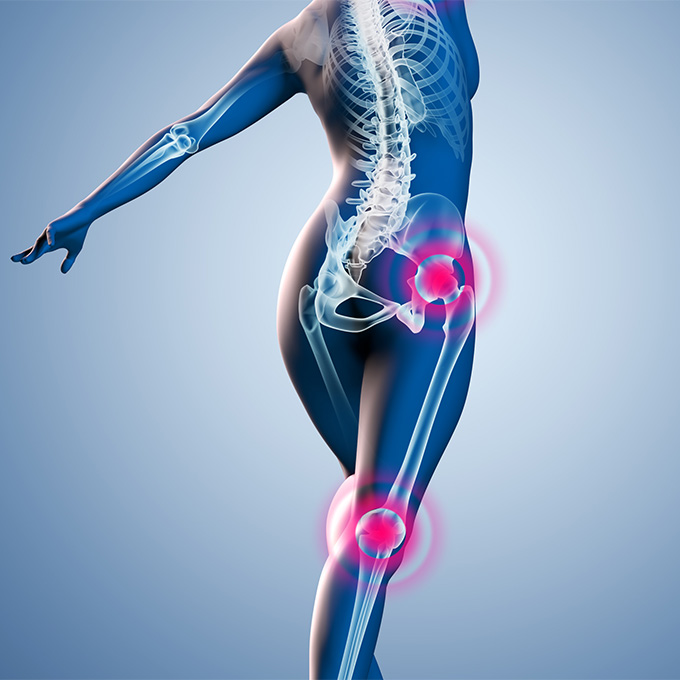ARTHROSIS
Knee and hip joints are most commonly affected by arthrosis

Arthrosis is the degeneration of the articular surfaces. The originally smooth and elastic cartilage layer, which protects the healthy joint against impact and friction, is progressively destroyed by arthrosis. If the bones of the joint end up directly rubbing against one another, they wear down or even deform. This results in severe pain and restricted movement – initially, only when subjected to specific strain, such as after a long walk. The more the disease progresses, the earlier the pain sets in. Pain that occurs even while at rest influences the quality of life of the patient in the final stage of hip or knee arthrosis.
Being joints that carry the weight of the body, the knee and hip are subjected to particularly intense strain and are frequently affected by arthrosis. However, arthrosis is not solely an age-related disease. Malnutrition, incorrect load distribution and the state of being overweight are three of the main reasons why more and more people develop arthrotic joint damage while they are still young. Studies show that there is significant vitamin E deficiency in the joint fluid of patients suffering from arthrosis.
Knee arthrosis
Knee joint arthritis (gonarthrosis) is the most common form of arthrosis
Our knee joint is constantly subjected to stress and strain. While carrying out everyday activities, such as climbing stairs or bending our knees while squatting, our weight strains these joints exponentially. Degeneration usually becomes apparent between the ages of 50 and 60, when signs of arthrosis, such as joint pain, set in when climbing the stairs or after long walks.
Knee arthrosis is abetted not only by age, but also by other factors, such as excess or inappropriate strain on the knee joints in the instance of knock knees or bow-leggedness, and by being overweight. Moreover, circulatory disorders, lack of exercise, sports accidents or injuries and joint inflammation caused by rheumatic or metabolic disorders, can cause knee arthrosis.
Hip arthrosis
Hip Arthrosis (coxarthrosis) is one of the most common hip disorders
The risk of developing hip arthrosis increases with age. X-ray examinations reveal signs of hip arthrosis in 20%-40% of 60-year-olds. Typical complaints are restricted movement and pain – predominantly in the groin and thigh area, as well as in the region of the buttocks and extending to the knee joint.
In the hip, too, the degenerative process is abetted by additional factors, such as years of extremely demanding physical labour, intense sports activities, being overweight or joint misalignment. Circulatory disorders of the femoral head, rheumatism, metabolic disorders or insufficient movement can also lead to hip arthrosis.
Joint replacement surgery
When is joint replacement surgery considered?
Joint replacement surgery is considered if the patient’s quality of life is greatly diminished owing to pain and restricted movement. In particular, chronic pain while at rest and at night is an indication of a disease requiring treatment.
Dr Knipprath has a wealth of experience in treating patients with hip and knee degenerative diseases.
Benefit from his experience and expertise to improve your quality of life.
You are welcome to make an appointment with Dr Johannes Knipprath.
Arrange an appointment on the telephone by calling 030 88 70 25 22 or 030 23 60 83 310.

